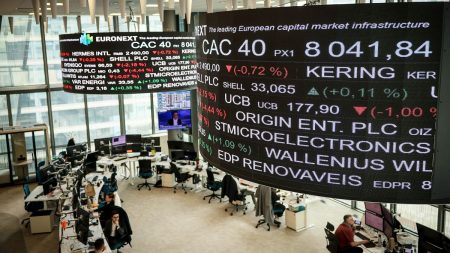In recent weeks, European markets have struggled to keep pace with global indices, despite the euro managing a rebound from two-year lows against the dollar. The turmoil stemming from political disturbances in France particularly hampered European stock performance, while US markets, invigorated by a post-Trump rally, saw significant gains with both the Dow and S&P 500 hitting new records. Asian markets exhibited a mixed picture; Australian stocks reached new heights driven by technological and healthcare sectors, while Chinese equities showed promise boosted by speculation regarding stimulus measures. Conversely, Japan experienced a downturn, with its stock indices reflecting ongoing uncertainties in the market.
The performance of European benchmarks varied as investor sentiment was weighed down by both global market instabilities and domestic political tensions, especially in France. The pan-European Stoxx 600 witnessed a slight decline of 0.23%, with France’s CAC 40 dipping by 2%. In contrast, Germany’s DAX and the UK’s FTSE 100 managed slight gains. The French market saw a brief recovery when Prime Minister Michel Barnier withdrew a controversial tax proposal affecting electricity pricing, which alleviated fears of a potential government collapse due to growing pressure from the far-right National Rally party. However, apprehension lingered as further demands from the National Rally concerning budgetary concessions loomed.
Bond markets reflect the growing anxiety surrounding France’s economic stability. Yields on French government bonds have slipped amid reduced selling pressure. However, these yields matched those of Greek bonds for the first time, raising alarm over a potential Greece-style fiscal crisis if the government fails to address its debts. The tension has led to a narrowing gap between French and German bond yields, yet it remains elevated, indicating persistent investor unease. The creditworthiness of France has come under scrutiny, especially following recent downgrades from major ratings agencies, leading to broader concerns about France’s ability to adhere to its financial targets.
Despite these challenges, the euro displayed resilience, rebounding against the dollar, although analysts caution that multiple bearish factors remain at play, such as geopolitical tensions, economic slowdowns, and domestic production issues within the Eurozone. The euro stabilized near 1.0670 after dipping to a two-year low, as the market adjusts to uncertainties surrounding French fiscal policies and broader economic conditions. Sector-specific effects have emerged in the European market; the auto and energy sectors faltered due to tariff threats and declining oil prices, respectively, while luxury goods showed signs of recovery on optimism surrounding Chinese economic stimulus actions.
In the United States, investor sentiment remained buoyant, leading to projected weekly gains across major indices as the Thanksgiving holiday approached. The assurance of a resilient economy and cooling inflation levels continued to energize the US markets, culminating in fresh all-time highs for both the Dow and S&P 500, with gains seen across most sectors except technology, which experienced some pullback. The Personal Consumption Expenditure (PCE) Index indicated inflationary pressures within expected ranges, reinforcing market confidence in an anticipated rate cut from the Federal Reserve. Consequently, US dollar performance took a slight hit amid easing government bond yields.
Across the Asia-Pacific region, trends displayed a contrasting trajectory; while Australia observed record gains in its equity markets, Chinese stocks remained beleaguered due to ongoing economic concerns. The Hang Seng and China A50 indices recorded declines, and the Yuan remained under pressure against the dollar, raising concerns about the region’s economic health. Japan’s Nikkei 225 also struggled, influenced by a strengthening Yen that diminished export competitiveness. Overall, while US markets thrive on political and economic maneuvers, and Australian equities showcase resilience, European counterparts grapple with political instability, and Asian markets face challenges from both domestic and global economic pressures.














